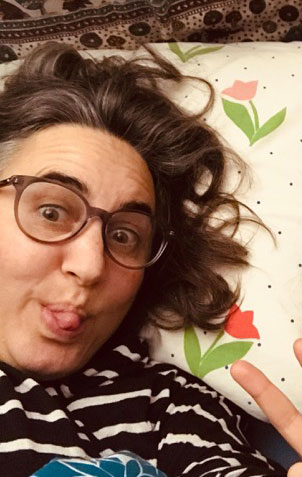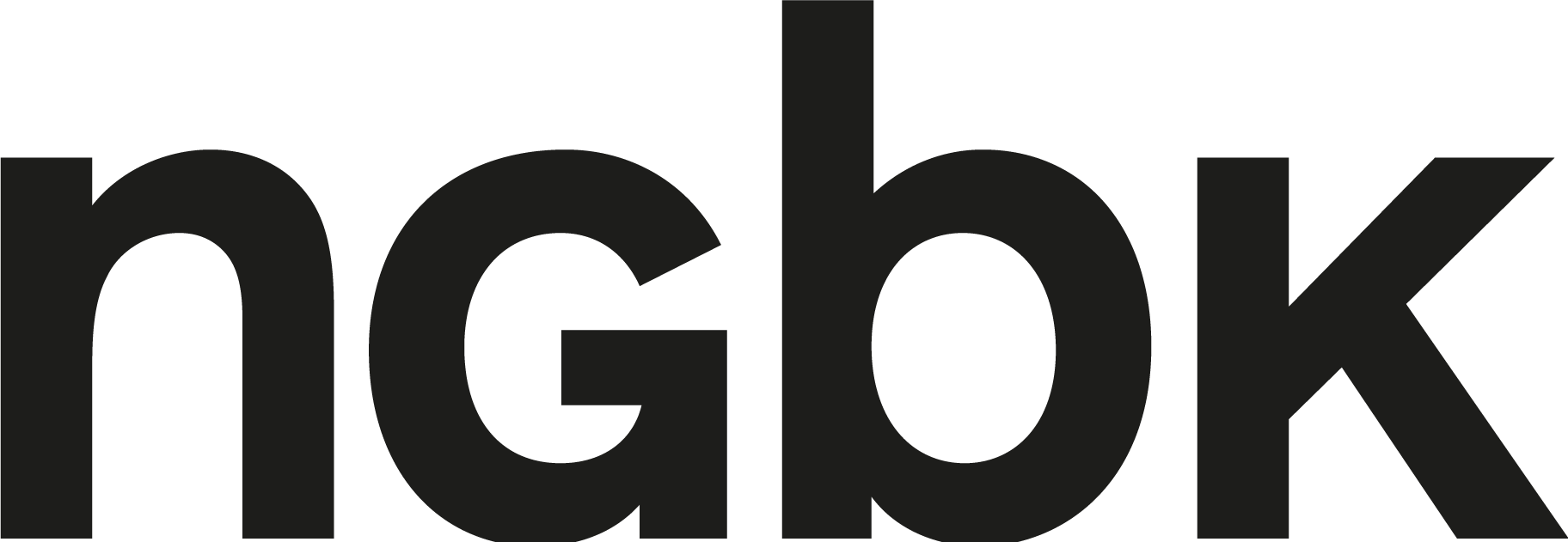Arrivals
Confronted with an apple when getting off the U-Bahn – I mean one on a billboard, not rolling carelessly down the platform or falling from the sky or offered from the window by a friendly old lady – a world-weary commuter might be tempted to buy it as a snack. That is, after all, what billboards do: they sell us that which, until that moment, we didn’t know we needed. But apples, humble as they are, compact and round, rarely need publicity. We pop them into our bags with little fanfare. We know they will patiently conserve their succulence in the dark. So why this billboard featuring a bright red shiny perfect apple, here at the U6 platform of Platz der Luftbrücke? Our eyes invite our mouths to water, and yet instead of tasty fruit we end up with an empty stomach and a full mind: the capacity of public art to provide food for thought.
If I were the Platz der Luftbrücke, I might harbor not a little envy for my cousins Alexander and Potsdamer. They suffered, to be sure, the indignities of bombing and the pain of becoming wastelands. Yet they rose from the ashes, palaces to consumerism and the ideological triumph of the West. They are not trapped in the clutch of forgotten history. I stand instead in Cold War ignominy, holding a monument known as the hungerclaw as though it were a monument to the growling stomachs of the Berlin Blockade (1948-49) rather than to the airlift that followed. Egal, at least I have Stephanie Hanna’s Peace Rug (Worauf basiert Frieden?) inviting people entering my U-Bahn station to think about how ironic it is that we ask the same questions about the same desires, and yet still fall into a state of perpetual war. At least I have my shiny apple falling from the sky… not unlike, I imagine, the food in the airplanes that saved my city so long ago.
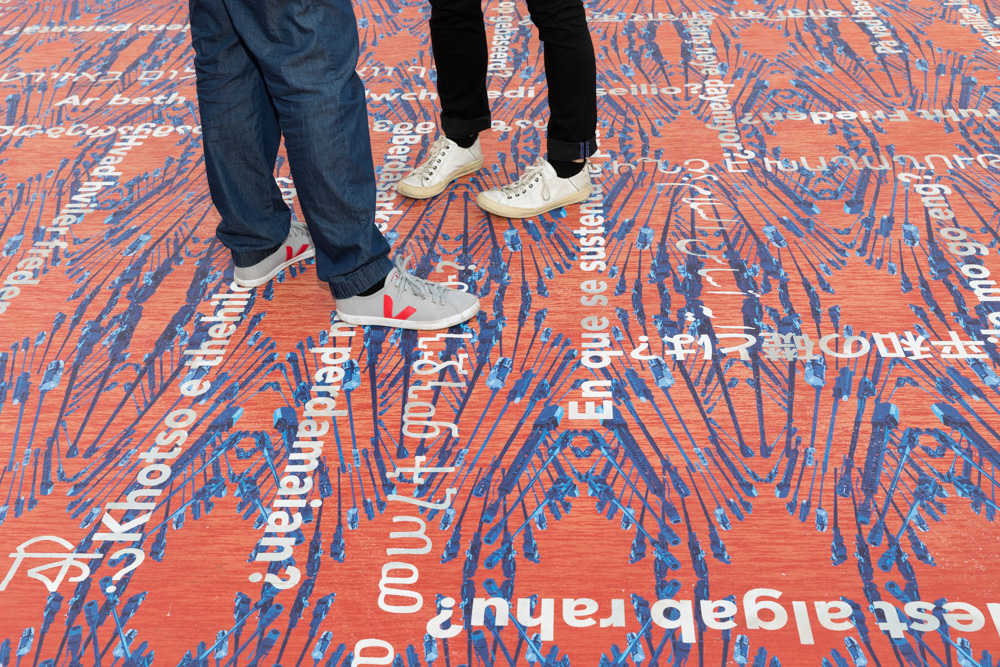
World-weary Berlin commuter that I am, I reach into the billboard to take the fruit between my fingers, yet it stays just outside my grasp. I look at the label, laser cut into the skin as so many labels are these days. Omer Xawer. Strange, I have never heard of that brand. I will try the other apple, on another billboard, across the platform. It also falls from the sky, large, succulent, temptingly sweet. Karl Kolb. Strange, isn’t that that… company? Under the large letters, I see the small print: Scientific Technical Supplies. My hunger sours my stomach. My apple seems less like one that might fall from a tree. The sweet scent rising from it makes my head spin. I’m nauseous. I can’t breathe. I fall.
My face falls onto a sign directing me to the Tempelhof Airport. I am no longer the world-weary commuter. I am the one who has commuted from across the world. I live in the transit zone. I live in the airport where no flights arrive and no flights leave, and I have no return as home has no more of a monument than my memory. I am a refugee. I have come from Halabja, in Iraqi Kurdistan. I am Omer Xawer. We all smelled the sweet scent of the apples before I died. Karl Kolb, whoever he is, I think he is the one who killed us. Or, at least he sold the gas to the one who killed us. He is not even a real person, but a puppet operated by people who find themselves without blame. Are you a puppeteer? I am the ghost in the apple and my soul lives in every refugee. My soul haunts you.
Have you eaten the apple? Eve eats the apple. Snow White eats the apple. Maybe when your people eat the apple, you don’t die. Maybe when your people eat the apple, your country gains in wealth what my country gains in death. It’s hard to say from behind the billboard. I find it very difficult to talk about apples, don’t you?
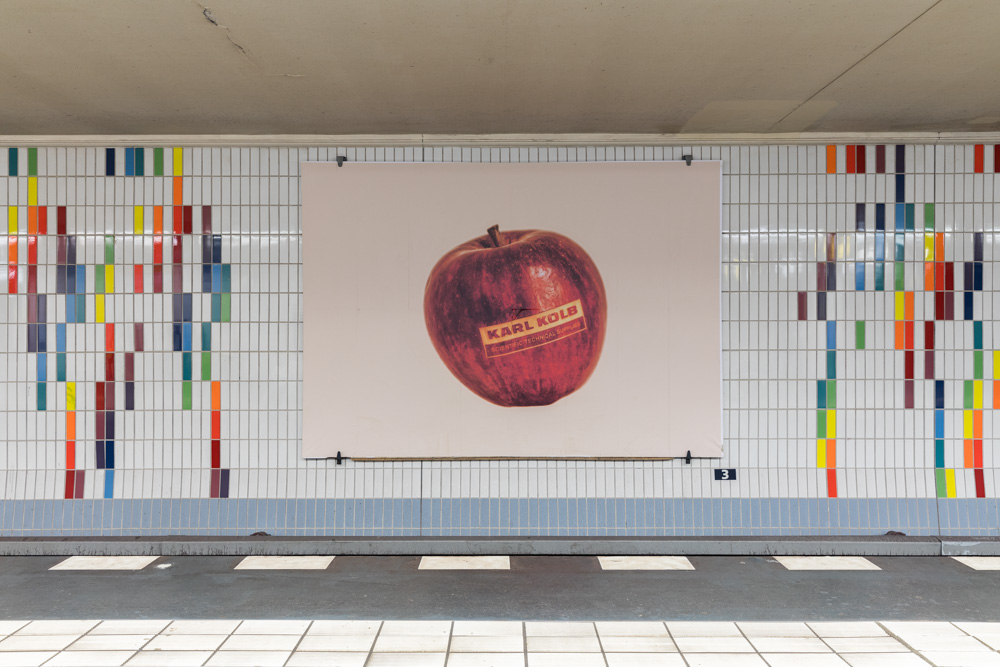
Let’s talk about art instead…
Art offers us a puzzle that we cannot quite solve. Less like a detective novel than like a dream, it gives us signs that refuse to resolve into sentences and yet offer some kind of truth. Through art, the victim mirrors the perpetrator, and there I stand in between. My mind is invited to bounce between words. It is invited to find its own path between words on a vehicle, often forgotten, of curiosity. It is invited out of the stupor of the given, into the liberty of exploration. It is invited, that is, off the train.
The train takes us through the city, underground. Its signs fleetingly point to what is above ground, yet in our rush to get where we are going, in our need to get through our own days, we rarely look up. We miss where we are, we miss what we do, we miss what we agree to. The train is the space of habit and the city is the life through which we must earn a living and protect our families and integrate ourselves into its workings to survive for the most part, or also, for the lucky few, to thrive. Life on the train does not encourage needless pauses. To linger on a platform is to loiter at the risk of taking too close a look at the apple.
The apple, as we all know from the European mistranslations of the Bible, represents knowledge. If we look at it closely, we find that we killed Omer Xawer, and this may be a truth that we do not want to see. The fact that we don’t know him personally no longer serves as an excuse when we face ourselves standing behind a corporate entity that acts through our acquiescence, Karl Kolb. We discover ourselves as his silent, unwitting puppeteers.
Art in public spaces can invite us to step off the train of habit and onto the platform of contemplation. Replacing anodyne invitations to purchase happiness, the artworks on billboards scattered around Berlin under the auspices of Up in Arms (this year’s edition of Art in the Underground) invite unwitting viewers into a mystery. The unsuspecting person entering the U-Bahn, waiting for a train, loitering on a platform, might try to put two and two together. Artworks invite us to experience insights when we least expect them, which is usually when the best insights come.
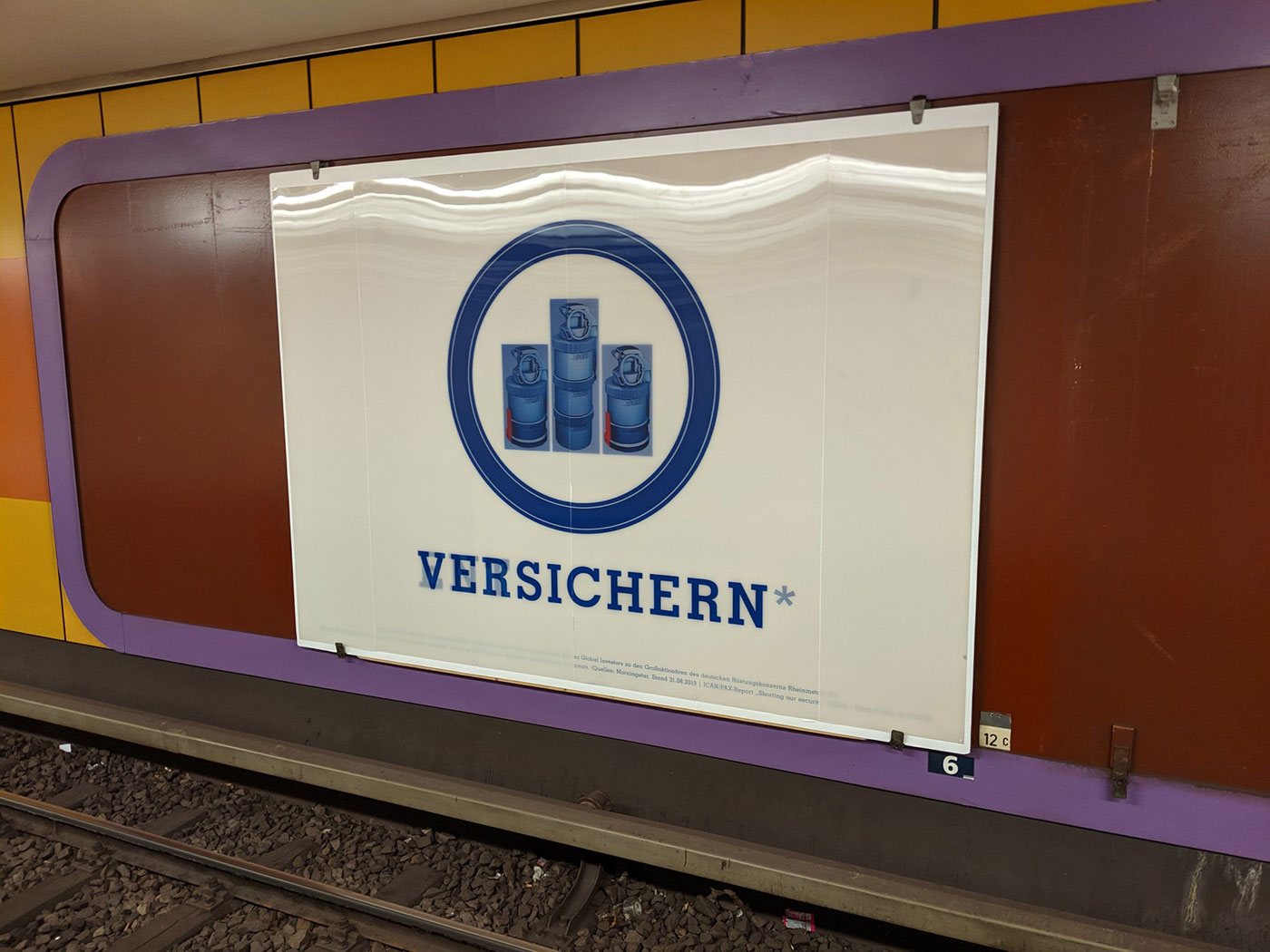
Like Miro Kaygalak’s Dual Use described above, Josefine Günschel’s work Versichern | Entsichern uses the medium of a billboard or a reticulated postcard to play on German grammar by shifting between the words versichern and entsichern imposed on the logo of the insurance company Alliance. As good inhabitants of Germany, we all versichern (insure) ourselves, yet the companies that insure us – no doubt Alliance serves as an example rather than an exception – enable the safety to be released (entsichern) from the grenade that represents the entire weapons trade upon which so much of European wealth depends. Our safety depends on the endangerment of others.
Similarly, Beatrice Schuett Moumdjian’s Forensic Excavations Inventory or the Total Deconstruction of an Armenian Family invites the loitering commuter to piece together mundane bits of family life laid out, as though on a crime sheet or a collage: mementos, old photographs, discarded toys, the detritus of life that adds up to a crime, in this case the Armenian Genocide of 1915. It turns out that the crime was not simply done over there, by the evils of the Ottoman Empire, but also over here, by the support of the Prussian Army. We remember, we were allies. And the damage done in the past never falls back together as a clean portrait. It remains forever disassembled, marred by the release of violence.
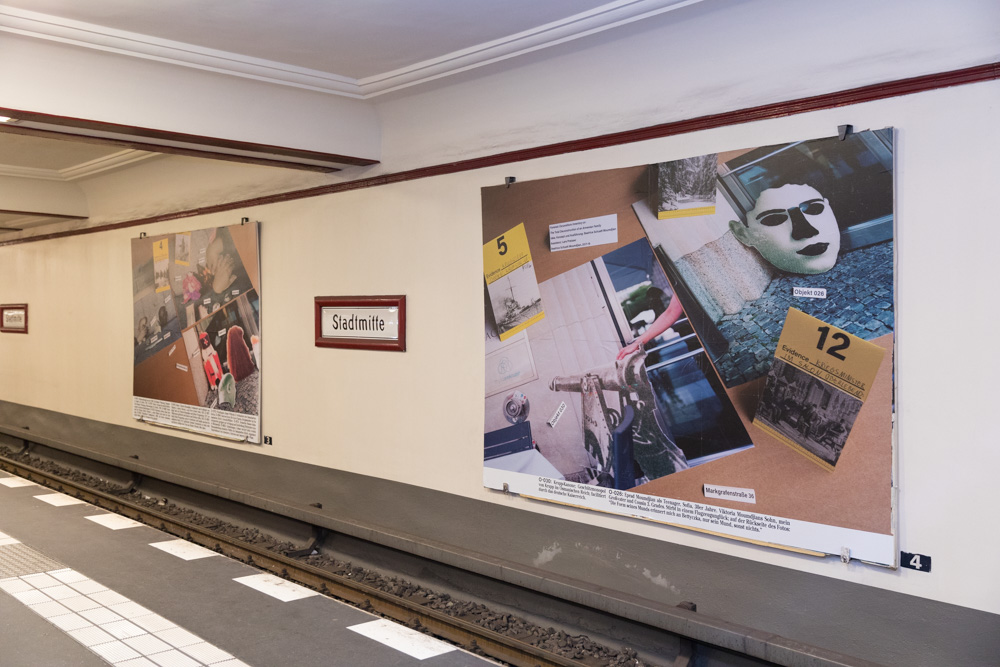
Art can escape the gallery in many forms. Fitte Kadenz, a collaboration between Alexis Dworsky and Cajus Heinzmann, transforms an apparent group of joggers engaged in fitness into a military troupe which, ironically, exposes the German arms industry. Running in formation through Berlin, the performers use a military cadence popularized through the 1987 film Full Metal Jacket (dir. Stanley Kubrick), which became central to a top UK popular music hit the same year. The cadence, part of the common cultural appropriation of African American arts (here a song-and-response work song) into broadly “American” practices, transforms the image of the military into a catchy, attractive means of collective participation. Like fitness itself, from yoga to crossfit, the cadence invites us to partake in habits that mimic and glorify the military in everyday life. The lyrics then reveal how deeply this complacency functions in our everyday environment, where much of Germany’s wealth and power emerges from the arms trade.
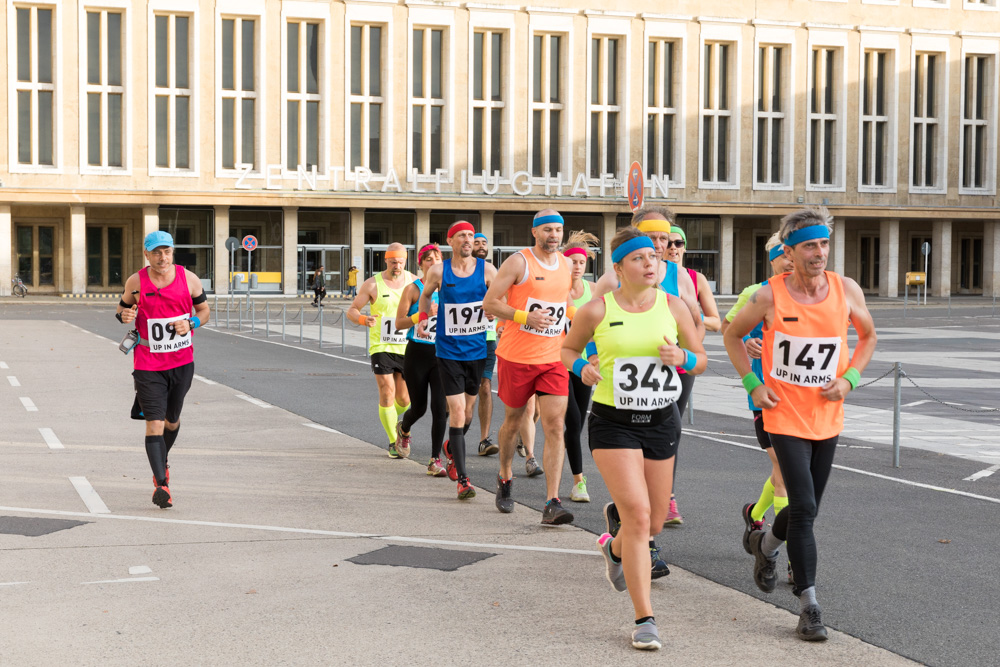
Departures
The insights these works invite are not those of culpability but of complicity. We are not, it turns out, innocent. Crimes are not committed alone, but with accomplices. We are, as individuals or as nations, these accomplices. We cannot sit back and self-righteously scold others for their violence. This may be particularly difficult to swallow for Germany where the entire narrative of the post-Cold War era has been written as a story of redemption from what is billed as the greatest crime of all time, the Holocaust. The culture of Holocaust memorialization has led, over generations, through various dominant phases of memorialization: attempts to forget by those who lived and suffered through the era of National Socialism; the organization of blaming the generation of their parents; and resentment at being rendered culpable for events that long preceded the birth of the third generation. The fall of the Berlin Wall thirty years ago has replaced the Luftbrücke as the monument to the Cold War, leaving the cataclysm of the Holocaust one step more removed. One wants to believe that there has to come a point when the past ends, the suffering atoned, the damage redeemed, the present has become whole again. Finally, the “we” that makes up Germany is “good”.
Complicity complicates this. Genocides often take place in silence, but no genocide takes place alone. Getting off the hook for the Holocaust doesn’t get you off the hook for supplying the gas for the massacre at Halabja or supporting the Ottoman Army clearing out the East from Armenians. Yet it does open the door in recognizing that the Germans have born the blame for the Holocaust mostly alone although, like so many others, this genocide took place in plain view, as other countries remained silently self-satisfied in the brew of their own hatred. Our culpability is complex, our atonement incomplete, and our damage is unending. No country is good.
Political art generally runs the danger of preaching to the converted. By the time one gets oneself to Kunstraum Kreuzberg/Bethanien to view the magnificent exhibit Up in Arms, bringing together artworks from past to present fighting against the seamless complicity of capitalism with war, one already knows the basic problem: that the pleasure-selling world of marketing hides a host of governmental and corporate interests that make money off of war. To say that the ongoing suffering of millions – drowning in the Mediterranean, burning in the desert, wasting away in refugee camps, sold into slavery in plain view as well as in lawless territories, exiled in mass from their homes, refused passage to new lives – repeats, mimics, and vastly expands the horrors of the Holocaust is not to belittle the Holocaust so much as to recognize in chagrin that it repeats rather than ends. And we are all complicit.
How can an exhibit bent on furthering political awareness and resistance get its message out of the gallery and onto the streets? The non-profit organization LobbyControl (which has collaborated with the project Up in Arms) organizes tours exposing the complicity of German companies with arms manufacture, provides one model. Yet like the gallery space, the initiative furthers the knowledge of those who are already aware of the problem. How does one address a public capable of caring but utterly unaware of the problem? Direct messaging runs the risk of alienating people: feeling accused of that which they cannot control, they will object that they are not to blame. The tactic of art in public places plays a subtle game. It recognizes that not everybody will reach for the fruit that is knowledge. But art awakens curiosity. It invites investigation. In the underground, there will be those who, like Eve, will take the bait.
More information about the art works realized for Art in the Underground: https://archiv.ngbk.de/en/projekte/kunst-im-untergrund-2019-arms/
